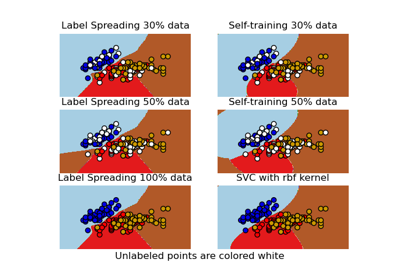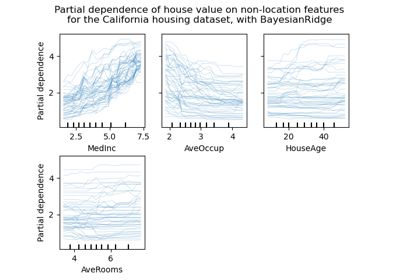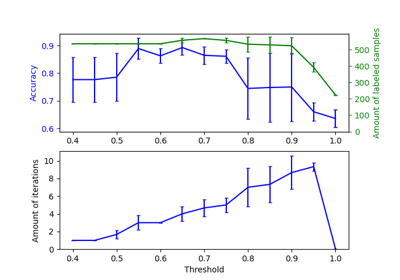sklearn.semi_supervised.SelfTrainingClassifier¶
- class sklearn.semi_supervised.SelfTrainingClassifier(base_estimator, threshold=0.75, criterion='threshold', k_best=10, max_iter=10, verbose=False)[source]¶
Self-training classifier.
This metaestimator allows a given supervised classifier to function as a semi-supervised classifier, allowing it to learn from unlabeled data. It does this by iteratively predicting pseudo-labels for the unlabeled data and adding them to the training set.
The classifier will continue iterating until either max_iter is reached, or no pseudo-labels were added to the training set in the previous iteration.
Read more in the User Guide.
- Parameters:
- base_estimatorestimator object
An estimator object implementing
fitandpredict_proba. Invoking thefitmethod will fit a clone of the passed estimator, which will be stored in thebase_estimator_attribute.- thresholdfloat, default=0.75
The decision threshold for use with
criterion='threshold'. Should be in [0, 1). When using the'threshold'criterion, a well calibrated classifier should be used.- criterion{‘threshold’, ‘k_best’}, default=’threshold’
The selection criterion used to select which labels to add to the training set. If
'threshold', pseudo-labels with prediction probabilities abovethresholdare added to the dataset. If'k_best', thek_bestpseudo-labels with highest prediction probabilities are added to the dataset. When using the ‘threshold’ criterion, a well calibrated classifier should be used.- k_bestint, default=10
The amount of samples to add in each iteration. Only used when
criterion='k_best'.- max_iterint or None, default=10
Maximum number of iterations allowed. Should be greater than or equal to 0. If it is
None, the classifier will continue to predict labels until no new pseudo-labels are added, or all unlabeled samples have been labeled.- verbosebool, default=False
Enable verbose output.
- Attributes:
- base_estimator_estimator object
The fitted estimator.
- classes_ndarray or list of ndarray of shape (n_classes,)
Class labels for each output. (Taken from the trained
base_estimator_).- transduction_ndarray of shape (n_samples,)
The labels used for the final fit of the classifier, including pseudo-labels added during fit.
- labeled_iter_ndarray of shape (n_samples,)
The iteration in which each sample was labeled. When a sample has iteration 0, the sample was already labeled in the original dataset. When a sample has iteration -1, the sample was not labeled in any iteration.
- n_features_in_int
Number of features seen during fit.
New in version 0.24.
- feature_names_in_ndarray of shape (
n_features_in_,) Names of features seen during fit. Defined only when
Xhas feature names that are all strings.New in version 1.0.
- n_iter_int
The number of rounds of self-training, that is the number of times the base estimator is fitted on relabeled variants of the training set.
- termination_condition_{‘max_iter’, ‘no_change’, ‘all_labeled’}
The reason that fitting was stopped.
'max_iter':n_iter_reachedmax_iter.'no_change': no new labels were predicted.'all_labeled': all unlabeled samples were labeled beforemax_iterwas reached.
See also
LabelPropagationLabel propagation classifier.
LabelSpreadingLabel spreading model for semi-supervised learning.
References
Examples
>>> import numpy as np >>> from sklearn import datasets >>> from sklearn.semi_supervised import SelfTrainingClassifier >>> from sklearn.svm import SVC >>> rng = np.random.RandomState(42) >>> iris = datasets.load_iris() >>> random_unlabeled_points = rng.rand(iris.target.shape[0]) < 0.3 >>> iris.target[random_unlabeled_points] = -1 >>> svc = SVC(probability=True, gamma="auto") >>> self_training_model = SelfTrainingClassifier(svc) >>> self_training_model.fit(iris.data, iris.target) SelfTrainingClassifier(...)
Methods
Call decision function of the
base_estimator.fit(X, y)Fit self-training classifier using
X,yas training data.get_params([deep])Get parameters for this estimator.
predict(X)Predict the classes of
X.Predict log probability for each possible outcome.
Predict probability for each possible outcome.
score(X, y)Call score on the
base_estimator.set_params(**params)Set the parameters of this estimator.
- decision_function(X)[source]¶
Call decision function of the
base_estimator.- Parameters:
- X{array-like, sparse matrix} of shape (n_samples, n_features)
Array representing the data.
- Returns:
- yndarray of shape (n_samples, n_features)
Result of the decision function of the
base_estimator.
- fit(X, y)[source]¶
Fit self-training classifier using
X,yas training data.- Parameters:
- X{array-like, sparse matrix} of shape (n_samples, n_features)
Array representing the data.
- y{array-like, sparse matrix} of shape (n_samples,)
Array representing the labels. Unlabeled samples should have the label -1.
- Returns:
- selfobject
Fitted estimator.
- get_params(deep=True)[source]¶
Get parameters for this estimator.
- Parameters:
- deepbool, default=True
If True, will return the parameters for this estimator and contained subobjects that are estimators.
- Returns:
- paramsdict
Parameter names mapped to their values.
- predict(X)[source]¶
Predict the classes of
X.- Parameters:
- X{array-like, sparse matrix} of shape (n_samples, n_features)
Array representing the data.
- Returns:
- yndarray of shape (n_samples,)
Array with predicted labels.
- predict_log_proba(X)[source]¶
Predict log probability for each possible outcome.
- Parameters:
- X{array-like, sparse matrix} of shape (n_samples, n_features)
Array representing the data.
- Returns:
- yndarray of shape (n_samples, n_features)
Array with log prediction probabilities.
- predict_proba(X)[source]¶
Predict probability for each possible outcome.
- Parameters:
- X{array-like, sparse matrix} of shape (n_samples, n_features)
Array representing the data.
- Returns:
- yndarray of shape (n_samples, n_features)
Array with prediction probabilities.
- score(X, y)[source]¶
Call score on the
base_estimator.- Parameters:
- X{array-like, sparse matrix} of shape (n_samples, n_features)
Array representing the data.
- yarray-like of shape (n_samples,)
Array representing the labels.
- Returns:
- scorefloat
Result of calling score on the
base_estimator.
- set_params(**params)[source]¶
Set the parameters of this estimator.
The method works on simple estimators as well as on nested objects (such as
Pipeline). The latter have parameters of the form<component>__<parameter>so that it’s possible to update each component of a nested object.- Parameters:
- **paramsdict
Estimator parameters.
- Returns:
- selfestimator instance
Estimator instance.
Examples using sklearn.semi_supervised.SelfTrainingClassifier¶

Decision boundary of semi-supervised classifiers versus SVM on the Iris dataset


